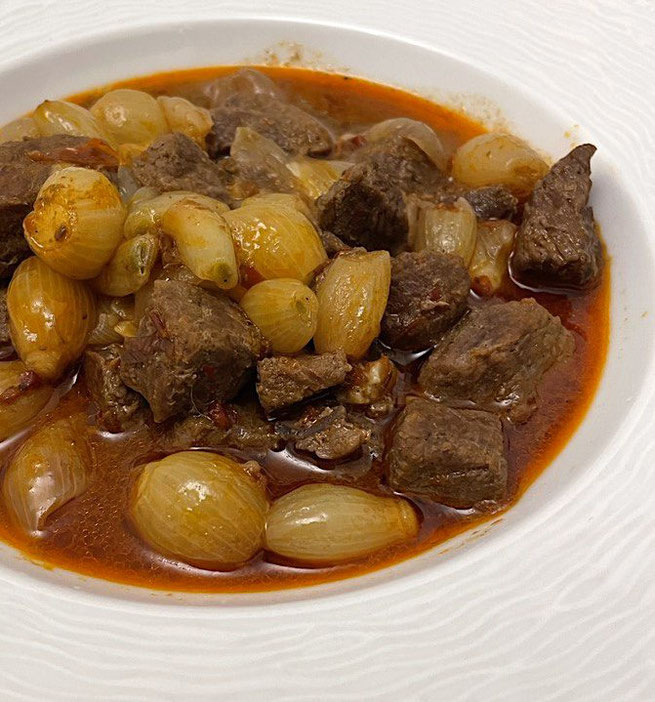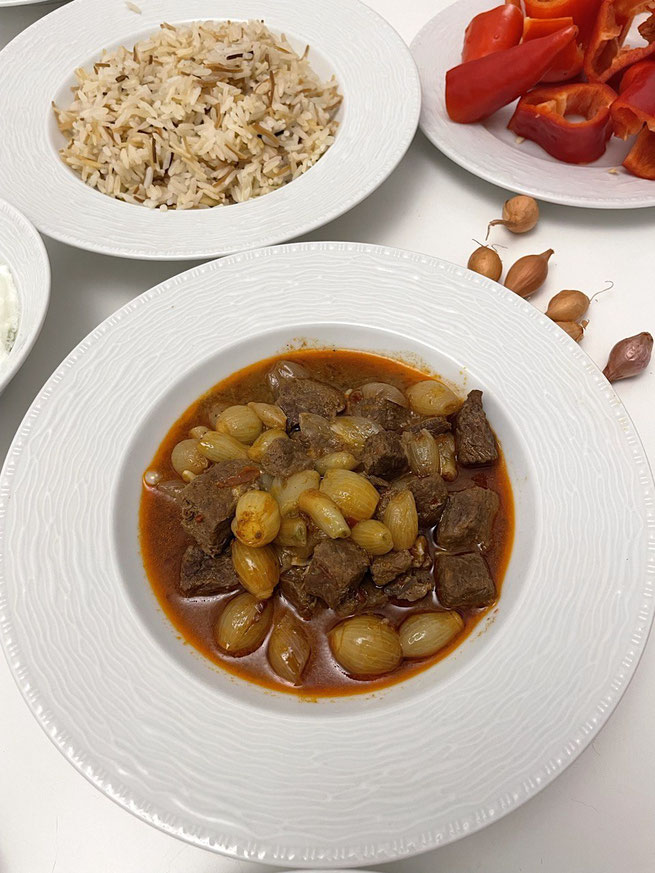
Cooked onions - a reason to argue for many. However, we are a fan of them, which is why we absolutely had to try today's recipe. We bought shallots for the first time in our lives. We used them to prepare the so-called Sogan Yahni recipe. But what is it all about?
What is sogan yahni?
Yahni generally stands for various ragout dishes. These are not only known in Turkey, but also in the Balkans and India. There, however, they are usually spelled "yakhni". In Turkey, yahni usually refers to sogan yahni, i.e. yahni with onions. Here, the onions are arpacik sogan, i.e. shallots.
In terms of preparation and taste, this yahni recipe is very similar to other stews in Turkish cuisine.
This Turkish dish with meat impresses with soft meat and a creamy, delicious broth with a few sweet shallots in between. The yahni recipe gets its flavor from the butter, garlic, a really, really good salca (tomato- and/or pepper paste), and the shallots.

What does "good salca" mean?
Salca refers to either tomato and/or pepper puree/paste. It can therefore be a mixture or consist solely of tomatoes or peppers. However, if you want really good salca, you don't get it from the supermarket. Yes, you can find Turkish salca, i.e. paprika or tomato puree, in Turkish supermarkets. Is it really really good? Well.
There is a reason why the so-called German-Turkish women prefer to come with canisters of salca from Turkey in the summer. Because here you buy the salca either in the Aktar or at the market. The farmers or simply people from the countryside offer their homemade salca. The difference to "branded salca" is huge. Cook a meal with the supermarket salca and one with the one from the village and you will taste it.
We are planning to do a more comprehensive product study on salca in the future. You will learn even more about it there. Nevertheless, you can of course also cook this yahni recipe with salca from the Turkish supermarket or even your standard tomato paste and it will taste delicious. For your next vacation in Turkey, however, we advise you to take a little salca with you. Or simply ask friends if they have some real salca for you.
How our Yahni recipe works
The Yahni recipe is pretty simple. The only intensive part is peeling the shallots. This can take time, while the Yahni recipe is otherwise simple. Incidentally, it is best to use a pressure cooker. This is exactly what we did, as our pressure cooker is always used for beef. However, if you have enough time, you can also cook the yahni in a normal pot.

What is the best way to serve Sogan Yahni?
Basically, you can use the same side dishes as with most Turkish meat dishes. These are
- Turkish rice or bulgur
- salad
- yoghurt or ayran
- pickled vegetables (mixed or just peppers)
For us, it was served with fluffy Turkish rice, yoghurt and sliced red peppers. Afiyet olsun!
Sogan Yahni recipe: Ragout with shallots
Ingredients (3 portions)
- 300 grams/10,5 oz beef cubes
- 400 grams/14 oz shallots
- 4 cloves of garlic
- 0.5 tbsp salca (paprika paste - alternatively tomato paste)
- 2 tbsp oil
- 1 tbsp butter
- salt and pepper
- a little cumin
Preparation
Step 1: First, cook the meat until almost(!) soft. We used the pressure cooker for this. Put the oil in the pot, fry the pieces of meat in it and pour water into the pot. The meat should be covered. Add salt, pepper and a little cumin. Cook the meat in the pressure cooker for a good 17 minutes (it doesn't have to be completely soft yet).
Step 2: While the meat is cooking, peel the shallots and garlic cloves. Cut the garlic into slices.
Step 3: Open the pressure cooker and add the shallots, salca, garlic and butter. Stir in the salca.
Step 4: If there is not much water left in the pot, add more water so that everything is just covered. You can now either cook the yahni recipe again in a pressure cooker for 8-10 minutes or finish cooking it in the same way without the lid until the shallots are soft.
You can of course also use a normal pot. However, the cooking time will then be longer.

Write a comment